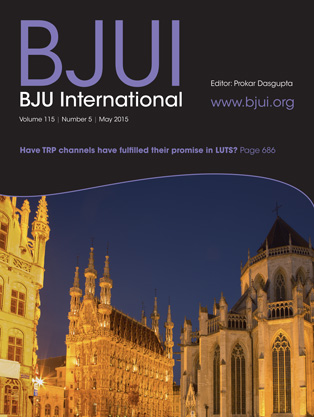
Transarterial Embolisation of Angiomyolipomas – Not so Cut and Dry
The month of May 2015 saw the International Urology Journal Club #urojc Twitter discussion move away from a cancer topic to a benign one. The discussion centred on the recent Journal of Urology paper entitled ‘Transarterial Embolization of Angiomyolipoma – A Systematic Review’. In this paper Murray et al presented a review of 524 cases of transarterial embolization (TAE) for AML in 31 studies (published between 1986 and 2013) with a mean follow up of 39 months.
The authors reported technical…

#AUA15 bursts to life in New Orleans
Creole cuisine, bustling Bourbon street, beads and beignets and 16,000 urologists. #AUA15 has just drawn to a close in the birthplace of Jazz; New Orleans, Louisiana #NOLA. With 2,598 abstracts being presented, over 2,500 speakers and representation from more than 100 countries it was undoubtedly an educational and action packed five days.
This was my first AUA and while I knew it was going to be a big conference I was stunned by the size of it all. There were urologists everywhere, so much…

The 3rd BJUI Social Media Awards – #AUA15 in New Orleans
What a fun destination we had for the 3rd Annual BJUI Awards! As you may know, we alternate the occasion of these awards between the annual congresses of the American Urological Association (AUA) and of the European Association of Urology (EAU). Our first awards ceremony took place at the AUA in San Diego in 2013, followed last year in Stockholm at the EAU. This year, we descended on New Orleans, Louisiana to join the 16,000 or so other delegates attending the AUA Annual Meeting and to enjoy all…

Editorial: Patients not p-values
A well powered study can attain statistical significance at a small effect size, but in real-life clinical practice, we do not routinely judge the success or failure of treatment based on the mean result for the hundreds of patients we have treated previously. Nor do we compare the response to treatment with what would have happened if we gave our patient a placebo; instead, clinical effectiveness is determined by the response of the individual patient seated across the desk in our clinic. In…

Editorial: The impact of the surgical correction of Peyronie’s disease – a patient’s perspective
Peyronie's disease (PD) is an acquired benign connective tissue disorder of the tunica albuginea of the penis that leads to the formation of fibrous inelastic plaques. As a result of pain, worsening quality of erections, penile shortening and deformity, the quality of life of both the patient and their partner may be significantly affected, and this may lead to depression, low self-esteem and relationship difficulties [1].
At present, surgery represents the ‘gold standard’ treatment…

The Drugs Don’t Work
12 Comments
/
For those pop enthusiasts amongst you, “The drugs don’t work” - the year was 1997; The band: The Verve. For those more urologically minded, you will immediately be thinking of the recent publication in the Lancet reporting on the use of tamsulosin and nifedipine vs. placebo for the medical expulsive therapy (MET) of ureteric stones. Current national (BAUS) and international (EAU guidelines) recommend the use of MET, usually with an alpha blocker – and often tamsulosin, and it has certainly…

Editorial: Selecting the right α-blocker – is silodosin your best option?
A significant proportion of aging men will have bothersome LUTS and will eventually seek help for this problem. Various medical therapies are available to help aleviate these symptoms. Amongst the various treatments, α-blockers are some of the most widely used drugs. Novara et al. [1] recently published a report on the efficacy and safety of silodosin in a pooled analysis of individual patient data from three registrational randomized controlled trials comparing silodosin and placebo in patients…

RSM Bladder Day
The urology section of the RSM left Wimpole Street and travelled up to sunny Queen Elizabeth Hospital in Birmingham on the 24th April to be educated in the 'Management of Non-Muscle invasive and Muscle Invasive Bladder Cancer'. This meeting was organised in collaboration with Nick James and Rik Bryan at the Birmingham Warwick Uro-Oncology unit as the RSM looks to add to its regional programme of teaching days.
The meeting was well attended by both experts as well as trainees and we kicked off…

Editorial: TRP channel – a reality that still requires many years of scientific efforts
Seventeen years have elapsed since the capsaicin receptor was first cloned by Caterina et al. [1] and the excellent review with an unusual provocative title by Deruyver et al. [2] was written. The capsaicin channel, re-named transient receptor potential (TRP) vanilloid receptor subtype 1 (TRPV1), is now commonly referred to as the founding member of the TRP family, as it currently includes 28 related channels, a number difficult to foresee in those early years [3].
TRP channels have…

Is maintenance BCG an unnecessary evil? Summary of the April 2015 #urojc
The current BCG shortage, and the effect this is having on our bladder cancer patients, is an issue that continues to weigh heavily on many urologists. With no immediate solution in sight, and limited availability, a variety of tactics are being advocated to optimally use the current supply.
The April 2015 International Urology Journal Club #urojc debate focused on the timely paper by Martínez-Piñeiro et al1. This paper reported the results of a randomised trial evaluating the outcomes of BCG…
